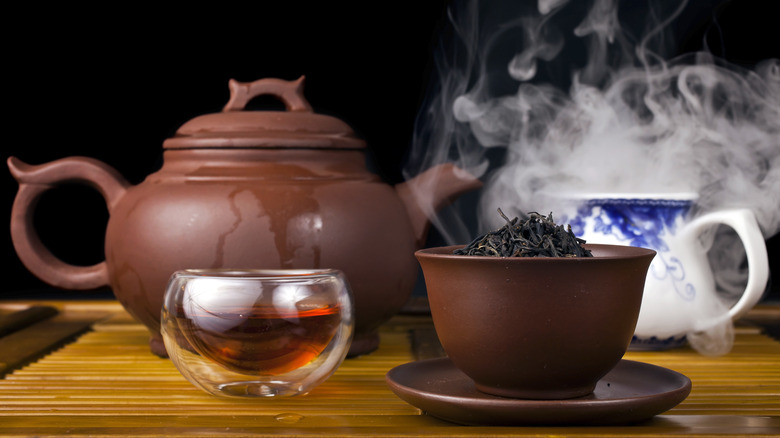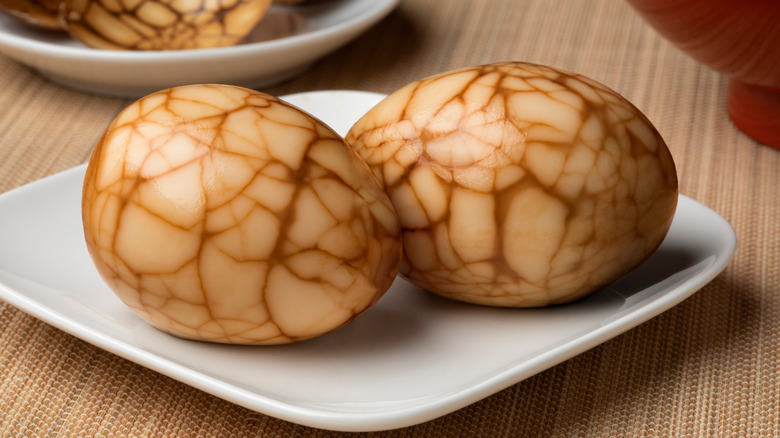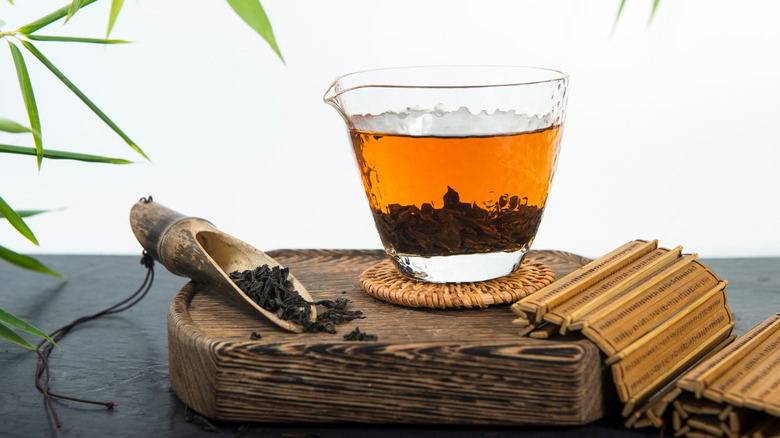The Secret Ingredient Tea To Add Smoky Flavor To Any Dish
Like the story of green tea's history as the accident that changed the world, the origin of lapsang souchong is also shrouded in legend. Believed to be the first black tea, its invention is said to date back to the 17th century in Fujian Province, China. There are a number of variations to the myth, but the tale revolves around soldiers who arrived to stay the night in a tea-producing village — some versions say they were raiders — forcing the farmers to leave quickly without being able to properly air dry their crop.
When the villagers returned, in order to not lose their entire harvest, they experimented with a quick-dry method of heating the leaves over burning pine wood. This sped-up process exposed the leaves to smoke, affecting the tea's flavor and aroma. Surprisingly, the Dutch merchants they were trading with liked and purchased it, and its popularity spread thereafter.
A more likely take is that green tea produced at the time was not able to withstand long voyages from Asia to other continents that had begun importing it, so new pine wood drying ovens were developed, resulting in the longer-lasting and blackened, smoked tea.
Lapsang souchong is widely enjoyed as a beverage, but its distinct smoky flavor makes it an interesting secret ingredient to cook with as well. It can be used to add a grilled taste to a variety of dishes, as a spice for meat and vegetables, or for making unique sauces and marinades.
Ways to cook with lapsang souchong tea
Lapsang souchong can be polarizing. Some appreciate its comforting campfire-like scent — while others contend that its tasting notes are reminiscent of bacon, pine sap, cigars, and even tar. When drunk as tea, its full-force intensity can be overwhelming. When used as a cooking ingredient, however, its more subtle qualities come through, lending food a warm, meaty flavor — perfect for adding a grilled or barbecued nuance without having to touch a grill. A strong brew of lapsang souchong makes an excellent stand-in for liquid smoke.
This savory, umami quality works well in vegetarian dishes, especially those that would otherwise be made with ham or beef, such as a lapsang-scented mushroom stroganoff. It also adds a depth of flavor to meat dishes where it can be used in a spice rub or directly on the meat as a crust. Grind the tea leaves into a fine powder and mix with other seasonings to use in chili and soups, or directly in cooking water for rice, grains, and pasta. It can be infused into cooking or finishing oils, as well as made into sauces and marinades for foods that would gain from its smokiness, such as chicken or tofu. Try it in a sweet syrup for cocktails and desserts.
Lapsang souchong is great for making tea and spice-soaked tea eggs. Traditionally eaten for Chinese New Year, the dark-colored tea is an ideal dye for giving the eggs their gorgeous, marbled appearance.
Why this tea is both beneficial and banned
Made from the Camellia sinensis plant, lapsang souchong shares the health benefits of other black teas due to high levels of antioxidants, especially polyphenols and flavonoids. According to Healthline, tea may possess anti-inflammatory properties thanks to antioxidants and other beneficial compounds, and these, in turn, may support overall health by reducing the risk of cancer, heart disease, stroke, type 2 diabetes, and other chronic illnesses. In addition, black tea may help to lower cholesterol and high blood pressure while aiding in gut health. Black tea contains less caffeine than coffee, and the presence of the amino acid L-theanine may both improve energy levels and cognitive focus without the anxiety that may come with higher caffeine consumption (per Medical News Today).
Ironically, lapsang souchong has been the focus of bans in Europe due to carcinogenic hydrocarbons that are released as wood burns. New regulations do allow for it to be roasted rather than smoked, which eliminates the danger of toxins affecting the tea. While some teas are still made using the traditional smoking method, your best bet is to seek out teas that are manufactured to meet current standards.
As a result of the European restrictions, authentic varieties have become harder to find and prices have skyrocketed. Likewise, fake versions flavored with artificial smoke have flooded the market. There are still many companies that sell the real thing, and genuine lapsang souchong distributors can be purchased from directly or through retailers like Amazon.



